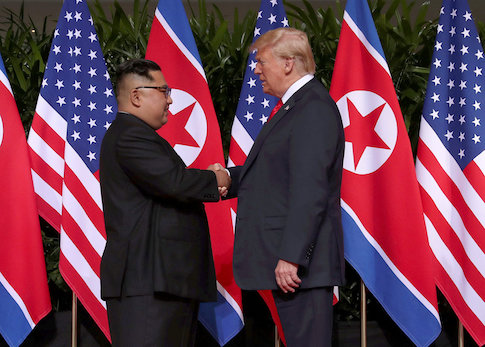By Jack Kim and Steve Holland
SINGAPORE (Reuters) - North Korean leader Kim Jong Un and U.S. President Donald Trump shook hands, smiling cautiously at the outset of their historic summit in Singapore on Tuesday, in which they will look for ways to end a nuclear standoff on the Korean peninsula.
"Nice to meet you Mister President," Kim said moments later as he sat alongside Trump, against a backcloth of North Korean and U.S. flags, beaming more broadly as the U.S. president gave him a thumbs up.
With cameras of the world's press trained on them, Trump and Kim built an initial atmosphere of friendship.
"I feel really great. We’re going to have a great discussion and will be tremendously successful. It's my honor and we will have a terrific relationship, I have no doubt," Trump said.
"It was not easy to get here....There were obstacles but we overcame them to be here," Kim replied.
Trump and Kim were due to hold a one-on-one meeting that could last around two hours, before they are joined by other officials and have lunch together.
Should they succeed in making a diplomatic breakthrough, it could bring lasting change to the security landscape of Northeast Asia, in a similar way to how the fall of the Berlin Wall in 1989 changed Europe.
With destiny calling, Trump was the first to arrive at the colonial-era Capella Hotel on Sentosa, a resort island off Singapore's port with luxury hotels, a Universal Studios theme park and man-made beaches.
While Trump and Kim search each other’s eyes and words for signs of trust or deceit, the rest of the world will be watching, hoping that somehow these two unpredictable leaders can find a way to defuse one of the planet's most dangerous flashpoints.
In the hours before the summit began Trump expressed optimism about prospects for the first-ever meeting of sitting U.S. and North Korean leaders, while U.S. Secretary of State Mike Pompeo injected a note of caution whether Kim would prove to be sincere about his willingness to denuclearize.
Officials of the two sides held last-minute talks to lay the groundwork for the summit of the old foes, an event almost unthinkable just months ago, when they were exchanging insults and threats that raised fears of war.
Staff-level meetings between the United States and North Korea were going "well and quickly," Trump said in a message on Twitter on Tuesday.
But he added: "In the end, that doesn't matter. We will all know soon whether or not a real deal, unlike those of the past, can happen!"
The combatants of the 1950-53 Korean War are technically still at war, as the conflict, in which millions of people died, was concluded only with a truce.
On Tuesday morning, Pompeo fed the mounting anticipation of diplomatic breakthrough: "We're ready for today."
Pompeo told reporters the event should set the framework for "the hard work that will follow", insisting that North Korea had to move toward complete, verifiable and irreversible denuclearisation.
North Korea, however, has shown little appetite for surrendering nuclear weapons it considers vital to the survival of Kim's dynastic rule.
Sanctions on North Korea would remain in place until that happened, Pompeo said. "If diplomacy does not move in the right direction ... those measures will increase."
He added: "North Korea has previously confirmed to us its willingness to denuclearize and we are eager to see if those words prove sincere."
The White House said later that discussions with North Korea had moved "more quickly than expected" and Trump would leave Singapore on Tuesday night after the summit, rather than Wednesday, as scheduled earlier.
Kim is due to leave on Tuesday afternoon, a source involved in the planning of his visit has said.
(Reporting by Steve Holland and Christophe Van der Perre; Additional reporting by Soyoung Kim, Dewey Sim, Aradhana Aravindan, Himani Sarkar, Kim Coghill, Robert Birsel, Miral Fahmy, Joyce Lee, Grace Lee, Matt Spetalnick and David Brunnstrom in Singapore and Christine Kim in Seoul; Writing by Matt Spetalnick and Clarence Fernandez; Editing by Simon Cameron-Moore)
